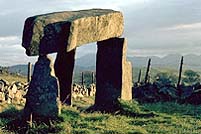Vacation Guide
Ireland golf vacation guide : To do and see
DOWN
 Downpatrick – literally translating to "St. Patrick’s Fort", a statue of the great saint stands on top of nearby Slieve Patrick. In 1176 John de Courcy claimed to have returned the remains of the saints Colmcille and Bríd here and it was he who added "Patrick" to the town’s name. Some believe Slieve Patrick to be the final resting place of the great saint and pilgrims regularly visit the site.
Downpatrick – literally translating to "St. Patrick’s Fort", a statue of the great saint stands on top of nearby Slieve Patrick. In 1176 John de Courcy claimed to have returned the remains of the saints Colmcille and Bríd here and it was he who added "Patrick" to the town’s name. Some believe Slieve Patrick to be the final resting place of the great saint and pilgrims regularly visit the site.
Grey Abbey – situated on the northeastern shores of Strangford Lough, this town is both a haven for the antique-shopper and also the site of perhaps the most complete Cistercian abbeys in Ireland.
Holywood Town – situated to the east of Bangor, Holywood is the site of a ruined 16th century Franciscan monastery and a 70-foot mast known as the maypole. Allegedly, when a Dutch ship ran aground in 1700 on May Eve, the mast was cut down and used as part of the "May Day" celebrations.
Legananny Portal Tomb – standing on the slope of Slieve Croob, this impressive portal tomb is probably Ulster’s most famous Stone Age monument. The nearby valley was the scene of the last battle of the United Irishmen, some of whom are buried in Saintfield.
 Mourne Mountains – immortalised in verse by the Percy French song "Where the Mountains of Mourne Sweep Down to the Sea", these spectacular mountains are 15 miles long and stretch between Newcastle and Rostrevor, filling the southeastern corner of County Down. Visitors may explore Silent Valley or climb Slieve Donard, the highest peak of the range.
Mourne Mountains – immortalised in verse by the Percy French song "Where the Mountains of Mourne Sweep Down to the Sea", these spectacular mountains are 15 miles long and stretch between Newcastle and Rostrevor, filling the southeastern corner of County Down. Visitors may explore Silent Valley or climb Slieve Donard, the highest peak of the range.
Rathfriland – the Brontë homeland is centred on Drumballyroney Parish School where Patrick Prunty (later Brontë) father to Charlotte, Anne and Emily taught. Patrick’s father was a storyteller, and it is thought that many of the stories heard by the sisters gave them inspiration for their novels.
Strangford Lough – lying to the south of Bangor, this 15-mile stretch of water is a maritime nature reserve of world importance. The Lough provides refuge for seals, particularly at its southern end, whilst thousands of seabirds spend the winter months here.
Ulster Folk and Transport Museum – set in the beautiful parkland estate of Cultra Manor, this extensive open-air museum gives impressions of rural and Urban Irish life over the past few centuries. It also houses the Irish Railway Collection, examples of the Dandy Horse (veteran motorcars) and a 1982 De Lorean gull-wing stainless car. Aircraft exhibits include the full-scale model of the monoplane used by Harry Ferguson, the first Irish person to fly.



